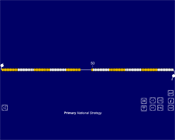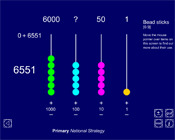Teaching guidance
This teaching guidance document suggests some of the key vocabulary, models, images and practical equipment that children should experience and be able to use. It also includes some teaching tips to provide a few starting points for ways of supporting children with this area of mathematics.
 Can I find pairs of numbers that total 100? - teaching guidance | 137KB
Can I find pairs of numbers that total 100? - teaching guidance | 137KB 
Consolidation and practice
These resources are to support children in guided or independent work. Roll over the highlighted resources for a description.
Counting on and back

This interactive teaching program (ITP) is an ICT-based tool to support the exploration of numbers to 100 through the simulation of a 100-bead string. Counting on and back ITP allows the child or teacher to add and subtract 1 or 10 to explore different counting and calculation strategies.
Bead sticks

This interactive teaching program (ITP) is an ICT-based tool to support the exploration of place value. Beadsticks ITP allows the child or teacher to represent numbers (with up to four digits) and explore addition and subtraction. An animation demonstrates the process of grouping and exchanging.
 = 100
= 100 + 82
+ 82 Knowing and using number facts
Knowing and using number facts




 3 +
3 +